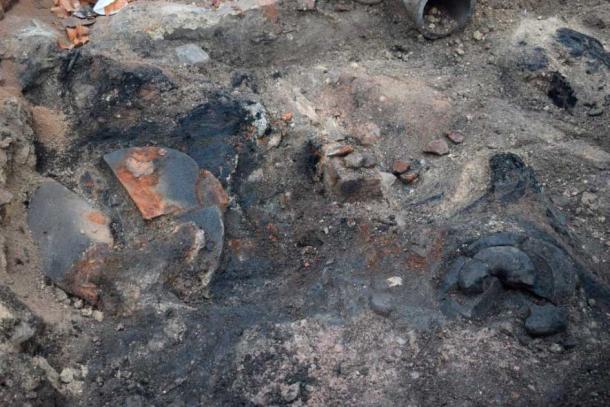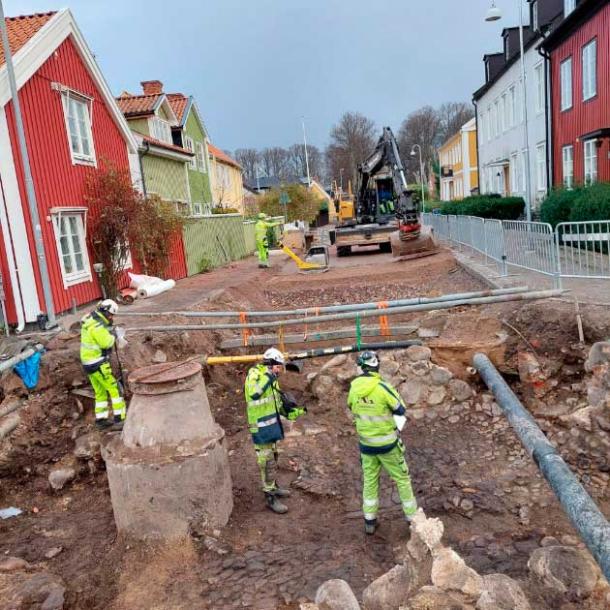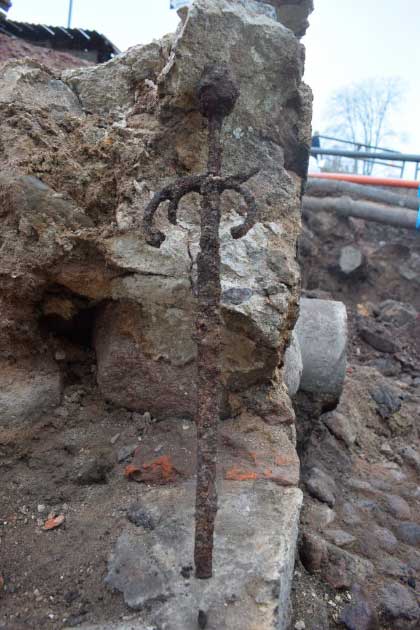
This Rare Battle-Sword Just Found in Sweden Is “An Evolutionary Leap”
Researchers in Sweden were excavating a 400-year-old cellar floor when they came across this “rare” battle-sword from the Military Revolution.
Archaeologists from Arkeologerna were digging at the intersection of the Kungsgatan and Västerlnggatan roads in the city of Kalmar, in the southeast of Sweden on the coast of the Baltic Sea.
Best known for its Renaissance-style Kalmar Castle, with turrets and a drawbridge, in the old town cobbled streets lead visitors along corridors of well-preserved 17th- and 18th-century buildings.
The Arkeologerna researchers discovered a cellar floor which records suggested was part of a medieval farm that belonged to “Gotskalk Hulskede in 1368 AD”. The farm property was again mentioned in a 1483 AD text and it is known that it burned down in the summer of 1611 AD during the Kalmar War.
A report in Heritage Daily says the archaeologists discovered “two severely burned hand grinders, a pile of charred grains, and broken brick, stone, and wood” most probably from the top floors of the houses covering the cellar's floor. And it was while they were removing collapsed roofing material that the “rare” Danish sword was discovered.
- The Crime of Sandby Borg: Site of a 1,600-Year-Old Tragedy in Sweden
- Mysterious Labyrinth and Ritual Caves: Archaeologists dig up the Stone Age Past on Swedish Island

Two heavily fire-damaged hand grinders. (Arkeologerna)
You Can Only Poke The Bear So Often!
The Kalmar War/Conflict was fought between Sweden and Denmark-Norway from 1611 AD to 1613 AD. Tensions began back in 1607 AD when King Charles IX of Sweden declared himself King of the Lapps, then taxed them, in what was traditionally Norwegian territory. Then, to get around paying tolls to Denmark and Norway for using the Øresund "Sound" strait, which separates the Baltic Sea and the North Sea, Sweden forged a new route via Lapland.
According to a report in TechTimes, this one toll “constituted up to two thirds of Denmark’s state income in the 16th and 17th centuries”. Not at all chuffed, in April 1611 AD King Christian IV of Denmark and Norway declared war upon Sweden and invaded from the south with 6,000 Danish soldiers.
The city and castle of Kalmar were known as the “key to Sweden,” because they controlled the Kalmar Straight and all shipping access to the northern trade routes on the Swedish east coast, and Stockholm. The 6,000 invaders had their weapons trained on first taking control of Kalmar’s castle, then the entire city, but things didn’t go according to plan.

The excavated stone cellar in a Kalmar street, where the battle sword was found. (Arkeologerna)
Lost in the Smoke of War
After several months of sieging, Danish forces successfully penetrated Kalmar’s city walls, but they failed to crush the Swedish forces and skirmishes continued until the death toll got to around 900 men (700 Swedish and 200 Danes). Eventually, England drew up peace terms which were guaranteed by King James I of England and VI of Scotland and the Peace of Knäred was signed on 21 January 1613 AD, bringing the Kalmar War to a close.
King Gustavus Adolphus of Sweden’s victory over Denmark set him on the path that would see him build his territory and army into a major regional power. This is why historians regard the conflict as a turning point in the history of armed conflict in Scandinavia. And it was in the aftermath of this war that the cellar burned causing its roof to collapse, covering the “rare” Swedish sword.

Excavations in Kalmar revealed, in the now exposed 17th century basement, lay the lost weapons of a Danish soldier. (Arkeologerna)
This Weapon Is ‘An Evolutionary Leap’
Arkeologerna said in a statement that at the time of the Kalmar War armies across Europe were experiencing “the military revolution.” An article in the defense publication, The Forge, explains the term ‘Military Revolution’ was originally coined in a paper delivered by Michael Roberts in 1955 to describe the period between 1560 AD and 1660 AD which saw new tactics and weapon systems being tested. These military changes brought about “significant transformation in warfare that contributed to the elevation of Western Europe as a center of world power,” according to Roberts.
Arkeologerna describes the rare sword as “an evolutionary leap” from the medieval sword, to more modern designs that would eventually dominate the 17th century battlefield. And symbolically, perhaps no better of an artifact could have been discovered to mark the Kalmar War, and Sweden’s first steps into the military revolution, than a broken and defeated Danish sword.
Top image: The Kalmar sword in situ where it was found. The tip is broken. Maybe in connection with battle? Source: Arkeologerna
By Ashley Cowie















